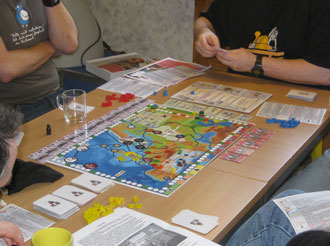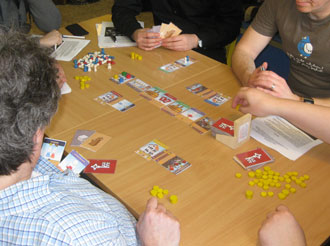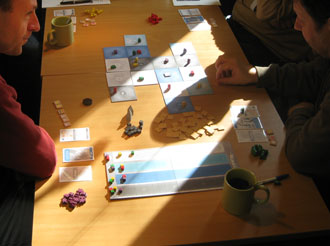Attention: The detailed description texts of the winning games have been automatically translated. There is a high probability of error.
 Erik der Rote Erik der RoteChristian Scheibner 2-5 players Erik der Rote (Eric the Red) is a card-driven worker placement game. The double-sided game board is well balanced for any number of players. 300 years of Viking history between 800 and 1100 A. D. set the topical background of this game. Settling, trading, and looting are the main activities of game play. Each player may perform 5 actions during each game round. There are certain rules how to use these actions and their success depends on the player’s hand cards that modify and support the actions. There are many ways to gain victory points and at the same time influence the other players gaining their victory points. This is done by placing your figurines on a common action board as well as on the common game board, thus creating handicaps and shifts of majority. With few random elements only, variable start and game round conditions, a partially variable game setup and several ways to trigger one of the differing game end conditions, this game offers a very high replay appeal. |
 Bier Barone Bier BaroneMalte Mertens 3-4 players As ambitious beer barons, 3 – 4 players try to establish their own breweries in order to supply their own pubs and taverns predominantly. This is done by displaying cards, and completed building cards may serve as income or victory points. As soon as the deck is exhausted, players will see who has established the most profitable beer business. Being beer barons, the players construct production sites and pubs, both of which require a lot of resources. The back sides of the other players’ hand cards show the available amounts of wood, stone and privileges. However, if a player constructs strong buildings too fast, they will fall behind in player order, thus suffering from fewer resources. Delivery contracts ensure permanent availability of resources and brewing and bar rights provide additional victory points. Work forces attracted by taverns and strong privileges help players to achieve their goals faster. During each game round, the players put two cards on display or pass, and at that passing may even offer ways to proceed, thus not being a wasted action. |
 Valhalla ValhallaPhil Walker-Harding 2-4 players The players assist the Nordic gods in building the mythic city of “Valhalla“ up in the clouds. They place workers in the city in order to create rain, hail, snow and lightning. These elements are used to erect the high towers of Valhalla. But only that player who builds their towers as equally as possible will win the game. During each game round, players place one worker on the city’s cloud districts in player order. Only one worker may be placed in each district during a game round. An evaluation is held at the end of each game round. Cloud districts of the same type form a region; the player with the majority of workers in a region gains the resources of this region. The start player is entitled to a special privilege – they may shift or exchange cloud districts, thus changing the size and location of the various districts, coupled with the related majorities. In turn, this affects all players in gaining resources. At the end of a game round the next player becomes the new start player, and making sure that all players are start player the same number of times. Bonus tiles offer another tactical element. They are placed on unused cloud districts at the beginning of each game round in order to increase their attractivity. Players may perform extra actions using these tiles. Despite its simple rules this game offers interesting tactical finesse. |
